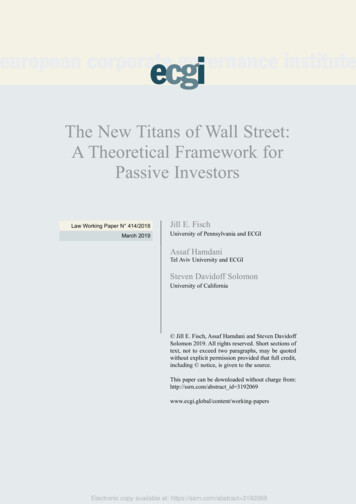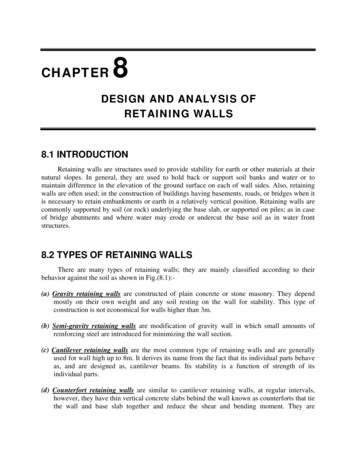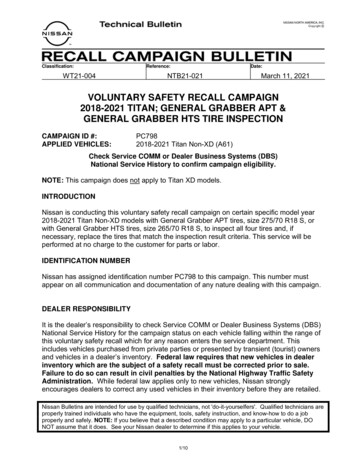
Transcription
The New Titans of Wall Street:A Theoretical Framework forPassive InvestorsLaw Working Paper N 414/2018March 2019Jill E. FischUniversity of Pennsylvania and ECGIAssaf HamdaniTel Aviv University and ECGISteven Davidoff SolomonUniversity of California Jill E. Fisch, Assaf Hamdani and Steven DavidoffSolomon 2019. All rights reserved. Short sections oftext, not to exceed two paragraphs, may be quotedwithout explicit permission provided that full credit,including notice, is given to the source.This paper can be downloaded without charge from:http://ssrn.com/abstract id ronic copy available at: https://ssrn.com/abstract 3192069
ECGI Working Paper Series in LawThe New Titans of Wall Street: A TheoreticalFramework for Passive InvestorsWorking Paper N 414/2018March 2019Jill E. FischAssaf HamdaniSteven Davidoff SolomonPreliminary drafts of this paper were presented at the Boston University School of Law, the Davies BusinessLaw Lecture Series at the Toronto Club, the Northwestern Pritzker School of Law, the NYU Law & EconomicsWorkshop, the Hastings Law & Economics Workshop, the Tulane Corporate and Securities Roundtable,the University of Pennsylvania Law School Institute for Law & Economics Corporate Roundtable and theUniversity of Wisconsin School of Law where we received many helpful comments. We are also grateful toDonna Anderson, Lucian Bebchuk, Glenn Booream, Alon Brav, Quinn Curtis, Merritt Fox, Zohar Goshen,Robert Jackson, Jr., Roy Katzovicz, Ann Lipton, Dorothy Shapiro Lund, Justin McCrary, Alessio Pacces, EdRock, Eric Roiter, Bonnie Saynay, Jeff Schwartz, Anne Tucker and Andrew Verstein for thoughtful comments. Jill E. Fisch, Assaf Hamdani and Steven Davidoff Solomon 2019. All rights reserved. Shortsections of text, not to exceed two paragraphs, may be quoted without explicit permission providedthat full credit, including notice, is given to the source.Electronic copy available at: https://ssrn.com/abstract 3192069
AbstractPassive investors — ETFs and index funds — are the most important development in modernday capital markets, dictating trillions of dollars in capital flows and increasingly owning much ofcorporate America. Neither the business model of passive funds, nor the way that they engagewith their portfolio companies, however, is well understood, and misperceptions of both have ledsome commentators to call for passive investors to be subject to increased regulation and evendisenfranchisement. Specifically, this literature takes a narrow view both of the market in whichpassive investors compete to manage customer funds and of passive investors’ participation inthe capital markets. We respond to this failure by providing the first comprehensive theoreticalframework for passive investment and its implications for corporate governance. To start, weexplain that, to understand passive funds, it is necessary to understand the institutional contextin which they operate. Two key insights follow. First, because passive funds are simply a poolof assets – their incentives are a product of the overall business operations of fund sponsors.Second, although passive funds are locked into their investments, their shareholders are not. Likeall mutual fund investors, shareholders in index funds can exit at any time by selling their sharesand receiving the net asset value of their ownership interest. Consequently, the sponsors of passivefunds must compete on both price and performance with other investment options – includingboth other passive funds and actively-managed funds -- for investor dollars. As we explain, thiscompetition provides passive fund sponsors with a variety of incentives to engage. Furthermore,the size of the major fund sponsors and the breadth of their holdings affords them economiesof scale enabling them to engage effectively. An examination of passive investor engagementin corporate governance demonstrates that passive investors behave in accordance with thistheory. Passive investors are devoting greater sophistication and resources to engagement withtheir portfolio companies and are exploiting their comparative advantages – their size, breadth ofportfolio and resulting economies of scale -- to focus on issues with a broad market impact, such aspotential corporate governance reforms, that have the potential to reduce the underperformanceand mispricing of portfolio companies. Passive investors use these tools, as opposed to analyzingfirm-specific operational issues, to reduce the relative advantage that active funds gain throughtheir ability to trade. We conclude by exploring the overall implications of the rise of passiveinvestment for corporate law and financial regulation. We argue that, although existing critiquesof passive investors are unfounded, the rise of passive investing raises new concerns aboutownership concentration, conflicts of interest and common ownership. We evaluate these concernsand the extent to which they warrant changes to existing regulation and practice.Keywords: Law and economics, corporate governance, securities law, passive investing, mutualfunds, ETFs, corporate finance, institutional investors, shareholder activism, capital marketsJEL Classifications: G11, G23, K22Jill E. Fisch*Perry Golkin Professor of LawUniversity of Pennsylvania, School of Law3501 Sansom StreetPhiladelphia, PA 19104, United Statesphone: 1 215 746 3454, fax: 1 215 573 2025e-mail: jfisch@law.upenn.eduAssaf HamdaniProfessor of LawTel Aviv University, The Buchmann Faculty of LawTel Aviv 6997801, Israele-mail: ahamdani@tauex.tau.ac.ilSteven Davidoff SolomonProfessor of LawUniversity of California, Berkeley School of Law693 Simon HallBerkeley, CA 94720, United Statese-mail: steven.solomon@law.berkeley.edu*Corresponding AuthorElectronic copy available at: https://ssrn.com/abstract 3192069
University of Pennsylvania Law SchoolILEINSTITUTE FOR LAW AND ECONOMICSA Joint Research Center of the Law School, the Wharton School,and the Department of Economics in the School of Arts and Sciencesat the University of PennsylvaniaRESEARCH PAPER NO. 18-12The New Titans of Wall Street:A Theoretical Framework forPassive InvestorsJill FischUNIVERSITY OF PENNSYLVANIAAssaf HamdaniTEL AVIV UNIVERSITYSteven Davidoff SolomonUNIVERSITY OF CALIFORNIA - BERKELEYThis paper can be downloaded without charge from theSocial Science Research Network Electronic Paper Collection:http://ssrn.com/abstract bleat:at:https://ssrn.com/abstract 3192069https://ssrn.com/abstract 3192069
The New Titans of Wall Street:A Theoretical Framework for Passive InvestorsJill FischAssaf HamdaniSteven Davidoff Solomon*March 2019 draftForthcoming U. Penn L. Rev. (2019)“If index funds underperform active funds, then assets will flow out from passives to actives.”-- Bill Ackman, CEO, Pershing Square International1AbstractPassive investors — ETFs and index funds — are the most important development inmodern day capital markets, dictating trillions of dollars in capital flows and increasinglyowning much of corporate America. Neither the business model of passive funds, nor the waythat they engage with their portfolio companies, however, is well understood, andmisperceptions of both have led some commentators to call for passive investors to be subject toincreased regulation and even disenfranchisement. Specifically, this literature takes a narrowview both of the market in which passive investors compete to manage customer funds and ofpassive investors’ participation in the capital markets.We respond to this failure by providing the first comprehensive theoretical framework forpassive investment and its implications for corporate governance. To start, we explain that, tounderstand passive funds, it is necessary to understand the institutional context in which theyoperate. Two key insights follow. First, because passive funds are simply a pool of assets – theirincentives are a product of the overall business operations of fund sponsors. Second, althoughpassive funds are locked into their investments, their shareholders are not. Like all mutual fundinvestors, shareholders in index funds can exit at any time by selling their shares and receiving*Jill Fisch is the Saul A. Fox Distinguished Professor of Business Law at the University of Pennsylvania School ofLaw; Assaf Hamdani is a Professor at Tel Aviv University, School of Law. Steven Davidoff Solomon is Professorof Law at the University of California Berkeley, School of Law. Preliminary drafts of this paper were presented atthe Boston University School of Law, the Davies Business Law Lecture Series at the Toronto Club, theNorthwestern Pritzker School of Law, the NYU Law & Economics Workshop, the Hastings Law & EconomicsWorkshop, the Tulane Corporate and Securities Roundtable, the University of Pennsylvania Law School Institute forLaw & Economics Corporate Roundtable and the University of Wisconsin School of Law where we received manyhelpful comments. We are also grateful to Donna Anderson, Lucian Bebchuk, Glenn Booream, Alon Brav, QuinnCurtis, Merritt Fox, Zohar Goshen, Robert Jackson, Jr., Roy Katzovicz, Ann Lipton, Dorothy Shapiro Lund, JustinMcCrary, Alessio Pacces, Ed Rock, Eric Roiter, Bonnie Saynay, Jeff Schwartz, Anne Tucker and Andrew Versteinfor thoughtful comments.1Email from Steve Fraidin, General Counsel Pershing Square Capital to Steven Davidoff Solomon dated May lableat:at:https://ssrn.com/abstract 3192069https://ssrn.com/abstract 3192069
the net asset value of their ownership interest. Consequently, the sponsors of passive funds mustcompete on both price and performance with other investment options – including both otherpassive funds and actively-managed funds -- for investor dollars. As we explain, this competitionprovides passive fund sponsors with a variety of incentives to engage. Furthermore, the size ofthe major fund sponsors and the breadth of their holdings affords them economies of scaleenabling them to engage effectively.An examination of passive investor engagement in corporate governance demonstratesthat passive investors behave in accordance with this theory. Passive investors are devotinggreater sophistication and resources to engagement with their portfolio companies and areexploiting their comparative advantages – their size, breadth of portfolio and resultingeconomies of scale -- to focus on issues with a broad market impact, such as potential corporategovernance reforms, that have the potential to reduce the underperformance and mispricing ofportfolio companies. Passive investors use these tools, as opposed to analyzing firm-specificoperational issues, to reduce the relative advantage that active funds gain through their abilityto trade.We conclude by exploring the overall implications of the rise of passive investment forcorporate law and financial regulation. We argue that, although existing critiques of passiveinvestors are unfounded, the rise of passive investing raises new concerns about ownershipconcentration, conflicts of interest and common ownership. We evaluate these concerns and theextent to which they warrant changes to existing regulation and practice.IntroductionPassive investors, or more accurately the large mutual fund complexes that manage mostof the assets invested in passively-managed funds, are the new power brokers of modern capitalmarkets.2 An increasing number of retail investors invest through exchange-traded funds (ETFs)and indexed mutual funds (collectively, index funds or passive funds), drawn by the lower costsof these products as well as a literature reporting that even savvy money managers cannotconsistently beat the market.3 This shift has concentrated a growing portion of the public capital2We note at the outset, the potential ambiguity in the term “passive investor.” A variety of rules-based investmentstrategies may be termed “passive,” such as algorithmic trading, and asset owners can employ a passive investmentstrategy without using a product such as a mutual fund or ETF. See, e.g., Andrew W. Lo, What is an Index, (Oct.12, 2015), available at https://papers.ssrn.com/sol3/papers.cfm?abstract id 2672755 (describing the breadth ofinvestment strategies that could be termed index investing and arguing that the critical characteristics of an index arethat it be transparent, investible and systematic). Moreover, as Adriana Robertson has convincingly demonstrated, itis somewhat misleading to term an index-based strategy “passive” in that the creation and choice of the index arethemselves managed investment strategies. See Adriana Robertson, Passive in Name Only: Delegated Managementand 'Index' Investing, 36 YALE J. REG. (forthcoming 2019). For purposes of this Article, we do not interrogatethese issues and employ the popular terminology of “passive investors” and focus on traditional index funds andETFs.3The popular press makes a broad claim that actively-managed funds systematically underperform index funds andtheir market benchmarks. See, e.g., Mark Hulbert, This is how many fund managers actually beat index funds,MARKETWATCH, (reporting that “Over the last 15 years, 92.2% of large-cap funds lagged a simple S&P 500 indexfund.”), available at srn.com/abstract 3192069https://ssrn.com/abstract 3192069
markets in the hands of the sponsors that operate these index funds, particularly the so-called bigthree of BlackRock, Vanguard and State Street.4 Although the extent to which index funds willcontinue to grow remains unclear, some estimates predict that by 2024 they will hold over 50%of the market.5Commentators have expressed concern, even alarm, over the growth of passive investorsand its implications for capital market efficiency and corporate governance.6 This literature,however, largely misconstrues or ignores the institutional structure of passive funds and themarket context in which they operate.7 As a result, it fails accurately to reflect the incentives ofpassive investors. Moreover, by marginalizing passive investors with assertions of apathy orcollusion, the literature has failed to appreciate the serious implications of the rise of passiveinvestment for corporate law and governance.We respond to that deficit. In this Article, we provide the first comprehensive theoreticalframework for passive investment. We use this framework to explore the role of passive funds— shareholders that do not exercise discretion over buying or selling shares — in corporategovernance. We then explore the overall implications of the increasingly influential role enjoyedby passive investors for corporate law, including the allocation of power between managementand shareholders, the regulation of voting, and the concentration of economic power.we-thought-2017-04-24. The story in the finance literature is more complex. See infra notes through andaccompanying text. See also Diane Del Guercio & Jonathan Reuter, Mutual Fund Performance and the Incentive toGenerate Alpha, 69 J. FIN. 1673 (2014) (finding “strong support . . . that actively managed funds earn the same afterfee alphas as index funds” within the “direct sold segment” of the mutual fund market).4See, e.g., Jan Fichtner, Eelke M. Heemskerk & Javier Garcia-Bernardo, Hidden Power of the Big Three? PassiveIndex Funds, Re-concentration of Corporate Ownership, and New Financial Risk, 19 Bᴜs. & Pᴏʟ. 238, 304 (2017)(explaining that BlackRock, Vanguard and State Street dominate the passive fund industry and terming them the“big three”).5See Trevor Hunnicutt, Index funds to surpass active fund assets in U.S. by 2024: Moody's, Rᴇᴜᴛᴇrs, Feb. 2, 2017,available at 2024-moodys-idUSKBN15H1PN.6See, e.g., Lucian A. Bebchuk, Alma Cohen & Scott Hirst, The Agency Problems of Institutional Investors, 31 J.ECON. PERS. 89, 90 (2017) (arguing that the rise of index investing has “systemwide adverse consequences ongovernance”); Dorothy Lund Shapiro, The Case Against Passive Shareholder Voting, J. Cᴏʀᴘ. L.(forthcoming 2018) (arguing that passive investors lack adequate incentives to become informed and shouldtherefore not be able to vote their shares); Shawn Langlois, Robert Shiller: Passive investing is a ‘pseudoscience’and it’s bad for markets, MARKETWATCH, Nov. 15, 2017, available at -markets-2017-11-14 (citing interview in which Nobelprize-winning economist Robert Shiller describes indexing as a “'chaotic system'” that’s taking a toll on the businesslandscape across the United States."). See also Eric A. Posner, Fiona M. Scott Morton & E. Glen Weyl, A Proposalto Limit the Anti-Competitive Power of Institutional Investors, Aɴᴛɪᴛʀᴜsᴛ L. J. (forthcoming 2017) (arguing thatownership concentration by the largest passive investors will undermine product market competition); Fiona ScottMorton & Herbert Hovenkamp, Horizontal Shareholding and Antitrust Policy, 127 Yᴀʟᴇ L.J. 1742 (2018) (same).7We note that, since we posted the initial draft of this article, scholars have posted several other pieces exploring therole and incentives of passive investors in more depth. See Lucian A, Bebchuk & Scott Hirst, The Index Funds andthe Future of Corporate Governance: Theory, Evidence and Policy, (December 27, 2018). ECGI - Law WorkingPaper No. 433/2018. Available at SSRN: https://ssrn.com/abstract 3282794; John C. Coates, The Future ofCorporate Governance Part I: The Problem of Twelve, Sept. 20 2018, available at SSRN:https://ssrn.com/abstract 3247337; Edward Rock & Marcel Kahan, Index Funds and Corporate Governance: LetShareholders be Shareholders (December 2018) NYU Law and Economics Research Paper No. 18-39, available atSSRN: https://ssrn.com/abstract lableat:at:https://ssrn.com/abstract 3192069https://ssrn.com/abstract 3192069
Commentators focus their criticism on two key attributes of passive funds. First, passivefunds, by virtue of their investment strategy, are locked into the portfolio companies they hold.They cannot exploit mispricing or other informational advantages through trading, nor can theyfollow the Wall Street rule and exit from underperforming companies the way traditionalshareholders, particularly active funds, can.8 Second, passive funds compete against otherpassive funds primarily on cost.9 Firm-specific research is costly, and passive funds cannotexploit that research to improve their performance. Critics therefore argue that it is irrational forpassive investors to research and monitor their portfolio companies.10We challenge this portrayal of the passive investor business model as incomplete andoffer a more nuanced approach. To start, while the term passive fund is widely used, it isfrequently misunderstood. Although a passive fund is a fund that is managed to track an index,there are a wide-variety of indexes, meaning that there is substantial variation among passivefunds. The construction and management of the index is not passive but entails a form ofmanaged investing. Although some indexes like the S&P 500 index are tracked by a largenumber of funds, other funds track a bespoke index that is created just for that fund.11 Somepassive funds also afford their managers a degree of discretion in choosing among the stocks onthe index or deviating from that index. Finally, although many passive funds have very low fees,those fees vary substantially.We then explain that, to understand passive funds, it is necessary to understand theinstitutional context in which they operate. The existing literature analyzes the behavior andincentives of passive investors at the level of the individual mutual fund. but overlooks the factthat an individual mutual fund is simply a pool of assets.12 A mutual fund’s actions areundertaken by third parties who have a contractual relationship with the fund.13 These thirdparties, whom we term “passive investors” are the fund sponsor, which establishes the fund andthe investment adviser, which makes the fund’s operational decisions and which is typically arelated entity.In the case of Fidelity, for example, Fidelity Investments, the fund sponsor, is a privatelyowned company which, in addition to offering over 500 mutual funds, designs and administersemployer-sponsored retirement plans and offers brokerage and other investment services.14Fidelity Management & Research Company is the investment advisor for Fidelity’s family of8See Anat R. Admati & Paul Pfleiderer, The “Wall Street Walk” and Shareholder Activism: Exit as a Form ofVoice, 22 Rᴇᴠ. Fɪɴ. Sᴛᴜᴅ. 2445 (2009) (explaining how shareholders can respond to poor performance through exit).9The literature notes that passive funds also compete on tracking quality. See, e.g., Ari Weinberg, Watch an IndexFund's 'Tracking Error', WALL ST. J., Jul. 9, 2012 (explaining tracking error and how it can vary among indexfunds).10See, e.g., Bebchuk, Cohen & Hirst, supra note 6, at 90 (arguing that “index funds have especially poor incentivesto engage in stewardship activities that could improve governance and increase value.”); Lund, supra note 6.11Roberston, supra note 2.12See Jill E. Fisch, Rethinking the Regulation of Securities Intermediaries, 158 U. PA. L. REV. 1961, 1968 (2010).13Id.14Fidelity, Fidelity by the Numbers: Corporate Statistics, abstract 3192069https://ssrn.com/abstract 3192069
mutual funds. BlackRock, Inc., a publicly-traded corporation is the sponsor of the BlackRockmutual funds, and its funds are managed by BlackRock Capital Investment Advisors LLC. 15 Forsimplicity, we will generally refer collectively to the fund sponsor and the investment adviser asthe sponsor.The incentives of these third parties drive fund behavior. Most significantly, sponsorsand advisers normally manage an entire family of funds, and the family usually includes amixture of passive and actively-managed funds. The sponsor’s business model involvesmaximizing the revenue from the entire family.16 That revenue, in turn, is a product of bothassets under management and fund fees. Importantly, at the passive investor level, thecompetition is between Fidelity and Vanguard, not between Fidelity’s Large Cap index fund andthe Fidelity Magellan Fund.17Similarly, it is important to distinguish between a mutual fund and the shareholders whoinvest in that fund. Although passive funds are locked into their investments, their shareholdersare not. Like all mutual fund shareholders, investors in index funds can exit at any time byselling their shares and, when they do so, they receive the net asset value of their ownershipinterest.18 As a result of this exit option, mutual funds compete for investors. Moreover, there isno reason to believe that index funds compete for investors only against other index fundstracking the same index. Rather, index funds compete, on an ongoing basis, with other passive(i.e. index) funds,19 with actively-managed funds,20 and with other investment options. Thiscompetition is not based solely on cost. Since mutual fund inflows are based on fund15BlackRock Advisors LLC is the sole managing partner of BlackRock Capital Investment Advisors LLC and is awholly-owned subsidiary of BlackRock, Inc. BlackRock Capital Investment Advisors LLC, SEC filing dated Mar.30, 2018, estment%20Management%20LLC.pdf at 1.16We observe that the other components of the business of mutual fund sponsors and advisers may affect theirincentives and operational decisions as well. For example, commentators have argued that a fund’s investmentadvisor may face a conflict of interest in voting the securities of a portfolio company when the advisor “alsomanages or seeks to manage the [company’s] retirement plan assets.”). See Disclosure of Proxy Voting Policies andProxy Voting Records By Registered Management Investment Companies, 68 Fed. Reg. 6564 (Feb. 7, 2003) at 20–2117Incentives operate somewhat differently at the level of the individual portfolio manager. Because passiveinvestors, especially the Big Three, most commonly vote and engage at the level of the fund family, these incentivesdo not present a significant concern for our analysis, but we flag potential issues in Part , infra.18See, e.g., John Morley & Quinn Curtis, Taking Exit Rights Seriously: Why Governance and Fee Litigation Don'tWork in Mutual Funds, 120 YALE L.J. 84, 89 (2010) (explaining the mutual fund shareholders can exit at net assetvalue, which is not affected by expected returns).19For example, Adriana Robertson collected data indicating that, in 2017, US mutual funds tracked 557 separateindexes. Robertson, supra note 2.20For evidence that active funds compete with passive ones, see generally Martijn Cremers et al., Indexing andActive Fund Management: International Evidence, 120 J. FIN. ECON. 539 ableat:at:https://ssrn.com/abstract 3192069https://ssrn.com/abstract 3192069
performance,21 passive investors risk losing assets if the performance of passive funds lags thatof actively-managed funds on a cost-adjusted basis.22In addition, a mutual fund shareholder is typically the customer of the entire mutual fundfamily. Individuals are likely both to invest in a single fund family and to own multiple fundsoffered by that family.23 Investing in a single fund family offers customers advantages such as aconsolidated statement and easy mechanisms for transferring assets between funds.24 As a result,the business model of a passive investor can be understood as competing both for assets and forcustomers. This explains why it may be rational for Fidelity to offer four index funds that chargeno management fee at all25 -- even though Fidelity does not receive any direct revenue from theassets that are invested in those funds.26 Indeed, when Fidelity began offering these funds, itwas the stock of other predominantly active fund sponsors that suffered.27Understanding the business model of passive investors leads to a comprehensive theoryof their incentives and behavior, a theory that we set forth in Part I. We first show thatcompetition with other fund sponsors gives passive investors, especially the largest passiveinvestors, incentives to engage in stewardship, and that fund families that manage a substantialamount of assets in passive funds have a distinctive need to preserve the attraction of passivefunds relative to active funds on a cost-adjusted basis.21See, e.g., Jonathan Lewellen & Katharina Lewellen, Institutional investors and corporate governance: Theincentive to increase value, working paper dated April 2018 (reporting that “a one percentage point increase in aninstitution’s benchmark-adjusted quarterly return predicts 1.31 percentage point (standard error of 0.13) increase innet inflow over the subsequent ten quarters”).22See, e.g., Susan E.K. Christoffersen, David K. Musto & Russ Wermers, Investor Flows to Asset Managers:Causes and Consequences, 6 ANN. REV. FIN. ECON. 289 (2014) (reviewing empirical literature on the factors thatinfluence the flow of funds into and out of mutual funds); Lewellen & Lewellen, supra note 21 (concluding that“inflows contribute significantly to institutions’ incentives”).23See, e.g., Edwin J. Elton, Martin J. Gruber & T. Clifton Green, The Impact of Mutual Fund Family Membershipon Investor Risk, 42 J. FIN. & QUANT. ANAL. 257 (2007) (“Individuals often make all of their mutual fundinvestments within one family of mutual funds.”).24See, e.g. Joshua Kennan, What is a Mutual Fund Family?, THE BALANCE, June 1, und-family-358178 (describing the advantages of investing within asingle fund family).25Fidelity initially offered two zero-fee index funds. Eric Rosenbaum, Fidelity's new no-fee index funds bring in 1billion in first month, CNBC, Sept. 4, 2018, available at l (describing Fidelity’s launch of zero fee funds). It subsequentlyexpanded its offerings to include four zero fee funds. See Fidelity, We're raising the bar on value, available ideas/indexfunds?imm pid 700000001009773&immid 100611&imm eid ep35415530159&gclid CjwKCAiA4t sP2TlLXW69WVWIwRoCmp8QAvD BwE&gclsrc aw.ds.26Fund sponsors receive additional revenue from the funds they manage both through commissions charged onsecurities transactions and through securities lending. These revenues are less a product of the fund’s investmentstrategy than the fund’s turnover rate and the borrowing demand for the securities held in the fund’s portfolio.27See Rosenbaum, supra note 25 (observing that “[s]ome of the fund companies hit hardest by the Fidelity movewere publicly traded managers known primarily for active mutual funds, such as Federated Investors, Legg Masonand Franklin Resources, which were down more than 5 percent on the day Fidelity announced the no-fee funds inearly availableat:at:https://ssrn.com/abstract 3192069https://ssrn.com/abstract 3192069
Specially, active funds compete based on their ability to generate alpha through the use oftheir investment discretion – choosing particular securities to under- and over-weight relative totheir benchmark and trading those securities on the basis of firm-specific informat
The New Titans of Wall Street: A Theoretical Framework for Passive Investors Electronic copy available at: https ://ssrn.com /abstract 3192069 . . Passive investors use these tools, as opposed to analyzing firm-specific operational issues, to reduce the relative advantage that active funds gain through their ability










